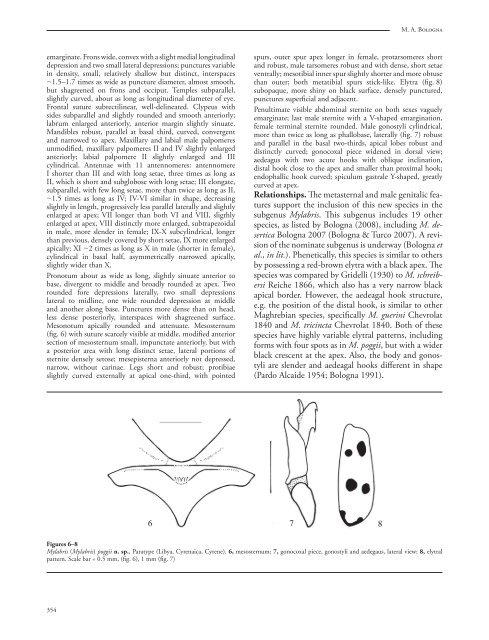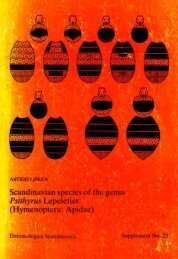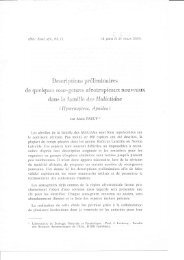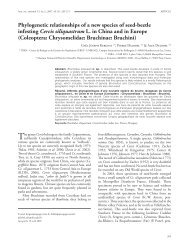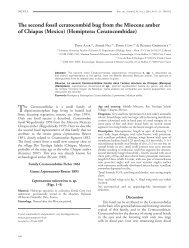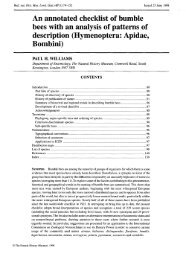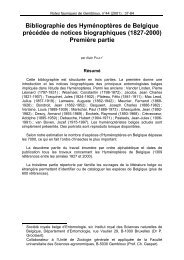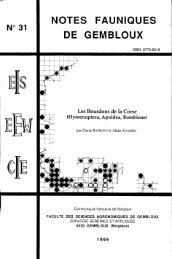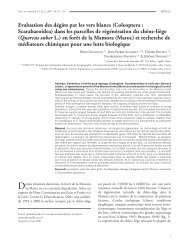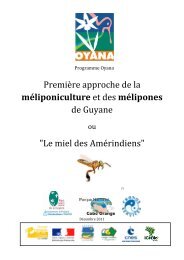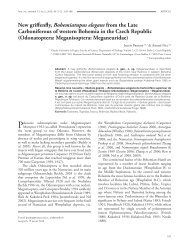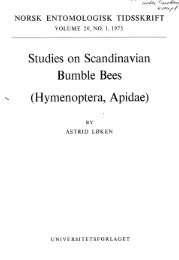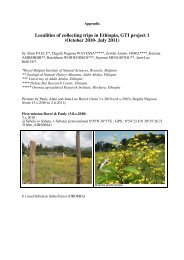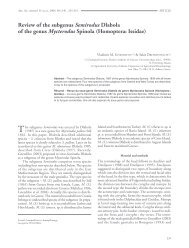Bologna 2009 - Beetles and Rock Art in Libya - Free
Bologna 2009 - Beetles and Rock Art in Libya - Free
Bologna 2009 - Beetles and Rock Art in Libya - Free
Create successful ePaper yourself
Turn your PDF publications into a flip-book with our unique Google optimized e-Paper software.
M. A. <strong>Bologna</strong><br />
emarg<strong>in</strong>ate. Frons wide, convex with a slight medial longitud<strong>in</strong>al<br />
depression <strong>and</strong> two small lateral depressions; punctures variable<br />
<strong>in</strong> density, small, relatively shallow but dist<strong>in</strong>ct, <strong>in</strong>terspaces<br />
~1.5–1.7 times as wide as puncture diameter, almost smooth,<br />
but shagreened on frons <strong>and</strong> occiput. Temples subparallel,<br />
slightly curved, about as long as longitud<strong>in</strong>al diameter of eye.<br />
Frontal suture subrectil<strong>in</strong>ear, well-del<strong>in</strong>eated. Clypeus with<br />
sides subparallel <strong>and</strong> slightly rounded <strong>and</strong> smooth anteriorly;<br />
labrum enlarged anteriorly, anterior marg<strong>in</strong> slightly s<strong>in</strong>uate.<br />
M<strong>and</strong>ibles robust, parallel at basal third, curved, convergent<br />
<strong>and</strong> narrowed to apex. Maxillary <strong>and</strong> labial male palpomeres<br />
unmodified, maxillary palpomeres II <strong>and</strong> IV slightly enlarged<br />
anteriorly; labial palpomere II slightly enlarged <strong>and</strong> III<br />
cyl<strong>in</strong>drical. Antennae with 11 antennomeres: antennomere<br />
I shorter than III <strong>and</strong> with long setae, three times as long as<br />
II, which is short <strong>and</strong> subglobose with long setae; III elongate,<br />
subparallel, with few long setae, more than twice as long as II,<br />
~1.5 times as long as IV; IV-VI similar <strong>in</strong> shape, decreas<strong>in</strong>g<br />
slightly <strong>in</strong> length, progressively less parallel laterally <strong>and</strong> slightly<br />
enlarged at apex; VII longer than both VI <strong>and</strong> VIII, sligthly<br />
enlarged at apex, VIII dist<strong>in</strong>ctly more enlarged, subtrapezoidal<br />
<strong>in</strong> male, more slender <strong>in</strong> female; IX-X subcyl<strong>in</strong>drical, longer<br />
than previous, densely covered by short setae, IX more enlarged<br />
apically; XI ~2 times as long as X <strong>in</strong> male (shorter <strong>in</strong> female),<br />
cyl<strong>in</strong>drical <strong>in</strong> basal half, asymmetrically narrowed apically,<br />
slightly wider than X.<br />
Pronotum about as wide as long, slightly s<strong>in</strong>uate anterior to<br />
base, divergent to middle <strong>and</strong> broadly rounded at apex. Two<br />
rounded fore depressions laterally, two small depressions<br />
lateral to midl<strong>in</strong>e, one wide rounded depression at middle<br />
<strong>and</strong> another along base. Punctures more dense than on head,<br />
less dense posteriorly, <strong>in</strong>terspaces with shagreened surface.<br />
Mesonotum apically rounded <strong>and</strong> attenuate. Mesosternum<br />
(fig. 6) with suture scarcely visible at middle, modified anterior<br />
section of mesosternum small, impunctate anteriorly, but with<br />
a posterior area with long dist<strong>in</strong>ct setae, lateral portions of<br />
sternite densely setose; mesepisterna anteriorly not depressed,<br />
narrow, without car<strong>in</strong>ae. Legs short <strong>and</strong> robust; protibiae<br />
slightly curved externally at apical one-third, with po<strong>in</strong>ted<br />
spurs, outer spur apex longer <strong>in</strong> female, protarsomeres short<br />
<strong>and</strong> robust, male tarsomeres robust <strong>and</strong> with dense, short setae<br />
ventrally; mesotibial <strong>in</strong>ner spur slightly shorter <strong>and</strong> more obtuse<br />
than outer; both metatibial spurs stick-like. Elytra (fig. 8)<br />
subopaque, more sh<strong>in</strong>y on black surface, densely punctured,<br />
punctures superficial <strong>and</strong> adjacent.<br />
Penultimate visible abdom<strong>in</strong>al sternite on both sexes vaguely<br />
emarg<strong>in</strong>ate; last male sternite with a V-shaped emarg<strong>in</strong>ation,<br />
female term<strong>in</strong>al sternite rounded. Male gonostyli cyl<strong>in</strong>drical,<br />
more than twice as long as phallobase, laterally (fig. 7) robust<br />
<strong>and</strong> parallel <strong>in</strong> the basal two-thirds, apical lobes robust <strong>and</strong><br />
dist<strong>in</strong>ctly curved; gonocoxal piece widened <strong>in</strong> dorsal view;<br />
aedeagus with two acute hooks with oblique <strong>in</strong>cl<strong>in</strong>ation,<br />
distal hook close to the apex <strong>and</strong> smaller than proximal hook;<br />
endophallic hook curved; spiculum gastrale Y-shaped, greatly<br />
curved at apex.<br />
Relationships. The metasternal <strong>and</strong> male genitalic features<br />
support the <strong>in</strong>clusion of this new species <strong>in</strong> the<br />
subgenus Mylabris. This subgenus <strong>in</strong>cludes 19 other<br />
species, as listed by <strong>Bologna</strong> (2008), <strong>in</strong>clud<strong>in</strong>g M. desertica<br />
<strong>Bologna</strong> 2007 (<strong>Bologna</strong> & Turco 2007). A revision<br />
of the nom<strong>in</strong>ate subgenus is underway (<strong>Bologna</strong> et<br />
al., <strong>in</strong> lit.). Phenetically, this species is similar to others<br />
by possess<strong>in</strong>g a red-brown elytra with a black apex. The<br />
species was compared by Gridelli (1930) to M. schreibersi<br />
Reiche 1866, which also has a very narrow black<br />
apical border. However, the aedeagal hook structure,<br />
e.g. the position of the distal hook, is similar to other<br />
Maghrebian species, specifically M. guer<strong>in</strong>i Chevrolat<br />
1840 <strong>and</strong> M. tric<strong>in</strong>cta Chevrolat 1840. Both of these<br />
species have highly variable elytral patterns, <strong>in</strong>clud<strong>in</strong>g<br />
forms with four spots as <strong>in</strong> M. poggii, but with a wider<br />
black crescent at the apex. Also, the body <strong>and</strong> gonostyli<br />
are slender <strong>and</strong> aedeagal hooks different <strong>in</strong> shape<br />
(Pardo Alcaide 1954; <strong>Bologna</strong> 1991).<br />
Figures 6–8<br />
Mylabris (Mylabris) poggii n. sp., Paratype (<strong>Libya</strong>, Cyrenaica, Cyrene). 6, mesosternum; 7, gonocoxal piece, gonostyli <strong>and</strong> aedegaus, lateral view; 8, elytral<br />
pattern. Scale bar = 0.5 mm, (fig. 6), 1 mm (fig. 7)<br />
354


